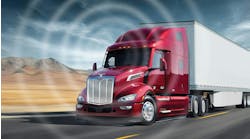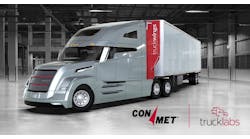The transportation industry is facing an interesting dilemma as 2018 matures into the second quarter. Many private fleets and for-hire carriers are now looking to replace older trucks with newer, more efficient units. However, several factors are reaching a boiling point forcing longer wait times from Original Equipment Manufacturers (OEMs) to complete orders for new trucks and ultimately move them into service.
Freight volumes are near all-time high levels, particularly as retailers look to restock shelves after a healthy holiday shopping season and online shopping continues its heated pace. According to the Federal Reserve in a report in The Wall Street Journal, industrial production had the largest year-over-year gain since 2010 this past December, meaning there’s more demand to ship goods across the country.
According to ACT Research, sales of Class 8 trucks jumped 59 percent to 296,440 vehicles in 2017. The firm estimated that manufacturers will receive orders for 305,000 Class 8 trucks in 2018, which would be a 19 percent gain. However, transportation intelligence provider, FTR Transportation Intelligence has raised its 2018 production forecast to 330,000 vehicles. Along with the healthy economy, recent changes to the corporate tax rate have incentivized firms further to replace trucks.
This poses an interesting dilemma for private fleets and for-hire carriers, particularly as they prepare their acquisition strategies going forward. Historically, many industry firms made purchase orders of trucks en masse and drove them for anywhere between five and ten years of service, or even longer, as a way to squeeze every penny out of the truck’s usage. However, what firms of all sizes are beginning to realize is that this acquisition strategy is not as cost effective compared to operating trucks at a shorter lifecycle. What’s more, they’re realizing they can achieve more savings on maintenance and repair by moving to a shorter lifecycle, the highest variable and volatile cost of a fleet operation.
Truck organizations are now paying closer attention to a truck’s individual “tipping point,” the point at which it costs more to operate a truck than it does to replace it with a newer model. Factors such as the cost of fuel, utilization, finance costs and maintenance and repair, are all factored into arriving at each truck’s unique tipping point, giving fleet operations personnel and finance departments a closer look based on data and analytics into determining and even predicting the optimum time to replace an aging truck.
More specifically, maintenance and repair represents a significant expense to operate a truck, in addition to fuel costs, which can fluctuate but still eat into profits no matter the price. According to a recent report and cost analysis, maintenance and repair costs on a 2012 sleeper model-year total $23,100, compared with $2,070 on a new, 2019 model-year truck, providing a savings of $21,030 for the first year. A closer look shows that the average per-mile maintenance and repair cost when operating two trucks over a four-year time period is just 6.18 cents per mile. However, this compares to 10.48 cents per mile when operating a single truck over a seven-year period. Over the course of seven years the lifecycle excess variable costs equate to $34,379 per truck, which runs into the millions on a fleet with 100 trucks.
Regardless of the changing price of fuel, there are big savings in replacing the asset model and moving out of older vehicles that are quite expensive to run and into a new model, which essentially resets your maintenance costs per mile to year one.
Trucks today are built with some of the most impressive technology and durability ever seen in the history of the industry. Original Equipment Manufacturers (OEMs) are constantly pushing the boundaries of efficiency and, thus, offering more product value than previous generations.
However, if a fleet is not taking advantage of these improvements, the costs associated with old equipment, out-of-service vehicles, miles accumulated on trucks, and rapidly advancing technology that makes certain repairs more elaborate, will start affecting the company’s overall bottom line.
While the decision on the up-front acquisition method could save millions on an entire fleet, shifting ongoing lifecycle management to a more flexible lease program would help those savings grow further, particularly as fleets grapple with disposal costs of older trucks. Innovative and flexible lease solutions today allow organizations to replace equipment prior to lease expiration (usually at or about 39 months) without penalty.
This approach offers flexibility to adapt to changing markets, ultimately driving down operational costs while strengthening the corporate image and driver recruitment and retention efforts by continuously upgrading to newer trucks. Companies are leveraging data analytics and comprehensive fleet studies that produce a fleet modernization and utilization plan, projecting when aging equipment will need to be replaced. This is especially effective with today’s fluctuating demand and the current booming economy as companies trying to acquire equipment solely based on demand are faced with equipment shortages and long lead times.
All of these decisions play a critical role in why today’s truck shortage is a growing issue. The legacy mindset of ordering trucks sporadically produces a bottleneck at the manufacture level, delaying the overall the fulfillment process. However, as fleets and carriers more closely analyze data analytics that pinpoint the optimum time for replacement of each individual truck, orders can be predicted over time and delivery of trucks can take on a more efficient process.
Michael D. Spence is senior vice president of Fleet Services, CTP, at Fleet Advantage, a company that focuses on truck fleet business analytics, equipment financing and lifecycle cost management. Spence has been in the transportation industry for more than 30 years, and at Fleet Advantage he serves on the Business Development team overseeing equipment lifecycle management, working with OEMs to guide equipment specs and purchasing for new equipment.



